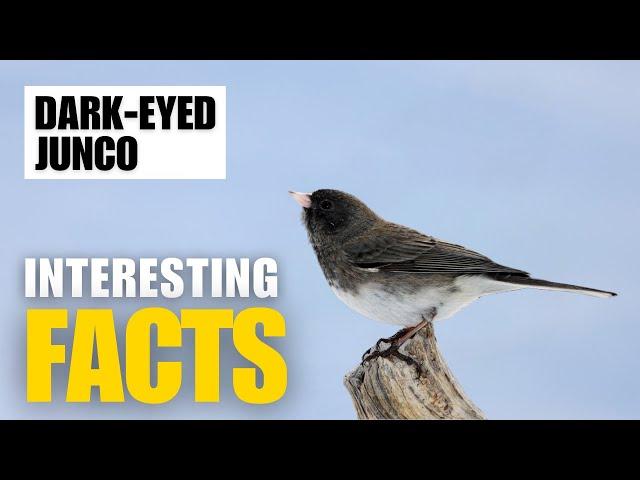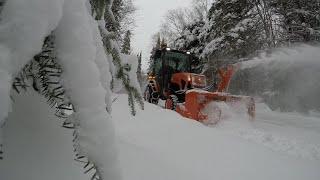
What Are the Most Fascinating Facts About Dark-Eyed Junco? | Interesting Facts | The Beast World
What Are the Most Fascinating Facts About Dark-Eyed Junco? | Interesting Facts | The Beast World
Dark-eyed Juncos (Junco hyemalis) are small, sparrows-like birds that are known for their distinctive plumage and behavior. Here are 70 amazing facts about Dark-eyed Juncos:
Name Origin: The scientific name "Junco hyemalis" is derived from Latin, with "Junco" meaning reed or rush, and "hyemalis" meaning winter.
Winter Visitors: Dark-eyed Juncos are often called "snowbirds" because of their tendency to migrate to lower elevations during the winter months.
Distinctive Plumage: Juncos have a distinctive plumage with a dark hood or cap on their heads and a gray or brown body.
Subspecies: There are several subspecies of Dark-eyed Juncos, each with slightly different plumage variations.
Geographic Range: Dark-eyed Juncos have a broad geographic range, spanning North America from the Arctic Circle to Mexico.
Habitat: They inhabit a variety of environments, including forests, fields, parks, and gardens.
Feeding Habits: Juncos primarily feed on seeds, but they also eat insects and berries.
Ground Foragers: These birds are ground foragers, often hopping around on the ground in search of food.
Migration: Many Dark-eyed Juncos migrate between their breeding grounds in the northern parts of North America and their wintering grounds in the south.
Breeding Season: Breeding season typically occurs during the summer months, with nesting in trees or shrubs.
Nest Construction: The female builds the nest, typically on or near the ground, using grasses, twigs, and other plant materials.
Egg Clutch: A typical clutch consists of three to six eggs.
Incubation Period: The female incubates the eggs for about 12-13 days.
Parental Care: Both parents take turns feeding and caring for the chicks.
Chick Development: Chicks fledge about 12-14 days after hatching.
Song: Dark-eyed Juncos have a sweet, musical trill or song.
Variety of Calls: In addition to their song, they have a variety of calls, including soft chirps and sharp notes.
Territorial Behavior: During the breeding season, males can exhibit territorial behavior, defending their nesting territory.
Population Size: The Dark-eyed Junco is one of the most common birds in North America, and its population is considered stable.
Color Variations: Plumage color can vary significantly among individuals, with some having darker or lighter markings.
Molt Patterns: Juncos undergo molt twice a year, changing their plumage for both the breeding and non-breeding seasons.
Social Birds: Outside of the breeding season, they often form flocks and roost together for protection.
Life Expectancy: In the wild, Dark-eyed Juncos typically live around 3-5 years.
Predators: Common predators include birds of prey, snakes, and mammals.
Band-tailed Junco: The subspecies "Junco hyemalis" includes the well-known "Oregon Junco" and "Slate-colored Junco."
White-winged Junco: Another subspecies, the "White-winged Junco," has distinctive white wing bars.
Pink-sided Junco: This subspecies has a pinkish hue on its sides.
Yellow-eyed Junco: Found in Arizona and New Mexico, this subspecies has yellow eyes.
Carolina Junco: This variant is found in the Appalachian Mountains and has a reddish-brown back.
Shifting Range: The Dark-eyed Junco's winter range has expanded northward in recent decades, likely due to changes in food availability.
Altitudinal Migration: Some populations exhibit altitudinal migration, moving up and down mountains in response to seasonal changes.
Adaptability: Juncos are adaptable birds and can thrive in a variety of environments, from urban areas to remote wilderness.
Elevational Variation: Different subspecies are adapted to different elevations, with some preferring lowlands and others thriving in mountainous regions.
Taxonomic Complexity: The taxonomy of Dark-eyed Juncos has been a subject of study and debate, with ongoing research refining our understanding of their relationships.
Temperature Tolerance: They are well-adapted to cold temperatures and can endure winter conditions.
Feather Puffing: In cold weather, Dark-eyed Juncos may puff up their feathers to create insulating air pockets.
Longevity Record: The oldest recorded Dark-eyed Junco lived to be over 11 years old.
Human Interaction: Juncos are known to visit bird feeders, especially during the winter months, making them a common sight in residential areas.
Birdwatching Favorite: Due to their prevalence and distinctive appearance, Dark-eyed Juncos are popular among birdwatchers.
Photogenic Birds: Their contrasting plumage and behaviors make them a favorite subject for bird photographers.
Migration Challenges: Migration can be challenging for Dark-eyed Juncos, as they face various obstacles such as predators, weather conditions, and habitat changes.
Winter Roosting: Juncos often roost in coniferous trees during winter nights for protection from predators and the cold.
#amazingfacts
#interestingfacts
#animals
#Dark-Eyed Junco
Dark-eyed Juncos (Junco hyemalis) are small, sparrows-like birds that are known for their distinctive plumage and behavior. Here are 70 amazing facts about Dark-eyed Juncos:
Name Origin: The scientific name "Junco hyemalis" is derived from Latin, with "Junco" meaning reed or rush, and "hyemalis" meaning winter.
Winter Visitors: Dark-eyed Juncos are often called "snowbirds" because of their tendency to migrate to lower elevations during the winter months.
Distinctive Plumage: Juncos have a distinctive plumage with a dark hood or cap on their heads and a gray or brown body.
Subspecies: There are several subspecies of Dark-eyed Juncos, each with slightly different plumage variations.
Geographic Range: Dark-eyed Juncos have a broad geographic range, spanning North America from the Arctic Circle to Mexico.
Habitat: They inhabit a variety of environments, including forests, fields, parks, and gardens.
Feeding Habits: Juncos primarily feed on seeds, but they also eat insects and berries.
Ground Foragers: These birds are ground foragers, often hopping around on the ground in search of food.
Migration: Many Dark-eyed Juncos migrate between their breeding grounds in the northern parts of North America and their wintering grounds in the south.
Breeding Season: Breeding season typically occurs during the summer months, with nesting in trees or shrubs.
Nest Construction: The female builds the nest, typically on or near the ground, using grasses, twigs, and other plant materials.
Egg Clutch: A typical clutch consists of three to six eggs.
Incubation Period: The female incubates the eggs for about 12-13 days.
Parental Care: Both parents take turns feeding and caring for the chicks.
Chick Development: Chicks fledge about 12-14 days after hatching.
Song: Dark-eyed Juncos have a sweet, musical trill or song.
Variety of Calls: In addition to their song, they have a variety of calls, including soft chirps and sharp notes.
Territorial Behavior: During the breeding season, males can exhibit territorial behavior, defending their nesting territory.
Population Size: The Dark-eyed Junco is one of the most common birds in North America, and its population is considered stable.
Color Variations: Plumage color can vary significantly among individuals, with some having darker or lighter markings.
Molt Patterns: Juncos undergo molt twice a year, changing their plumage for both the breeding and non-breeding seasons.
Social Birds: Outside of the breeding season, they often form flocks and roost together for protection.
Life Expectancy: In the wild, Dark-eyed Juncos typically live around 3-5 years.
Predators: Common predators include birds of prey, snakes, and mammals.
Band-tailed Junco: The subspecies "Junco hyemalis" includes the well-known "Oregon Junco" and "Slate-colored Junco."
White-winged Junco: Another subspecies, the "White-winged Junco," has distinctive white wing bars.
Pink-sided Junco: This subspecies has a pinkish hue on its sides.
Yellow-eyed Junco: Found in Arizona and New Mexico, this subspecies has yellow eyes.
Carolina Junco: This variant is found in the Appalachian Mountains and has a reddish-brown back.
Shifting Range: The Dark-eyed Junco's winter range has expanded northward in recent decades, likely due to changes in food availability.
Altitudinal Migration: Some populations exhibit altitudinal migration, moving up and down mountains in response to seasonal changes.
Adaptability: Juncos are adaptable birds and can thrive in a variety of environments, from urban areas to remote wilderness.
Elevational Variation: Different subspecies are adapted to different elevations, with some preferring lowlands and others thriving in mountainous regions.
Taxonomic Complexity: The taxonomy of Dark-eyed Juncos has been a subject of study and debate, with ongoing research refining our understanding of their relationships.
Temperature Tolerance: They are well-adapted to cold temperatures and can endure winter conditions.
Feather Puffing: In cold weather, Dark-eyed Juncos may puff up their feathers to create insulating air pockets.
Longevity Record: The oldest recorded Dark-eyed Junco lived to be over 11 years old.
Human Interaction: Juncos are known to visit bird feeders, especially during the winter months, making them a common sight in residential areas.
Birdwatching Favorite: Due to their prevalence and distinctive appearance, Dark-eyed Juncos are popular among birdwatchers.
Photogenic Birds: Their contrasting plumage and behaviors make them a favorite subject for bird photographers.
Migration Challenges: Migration can be challenging for Dark-eyed Juncos, as they face various obstacles such as predators, weather conditions, and habitat changes.
Winter Roosting: Juncos often roost in coniferous trees during winter nights for protection from predators and the cold.
#amazingfacts
#interestingfacts
#animals
#Dark-Eyed Junco
Тэги:
#Unbelievable_Facts_About_Dark-Eyed_Junco #Where_Do_Dark-Eyed_Junco_Come_From? #How_to_Uncover_the_Fascinating_Facts_of_Dark-Eyed_Junco? #The_Fascinating_Facts_About_Dark-Eyed_Junco_:_A_Comprehensive_Guide #Where_Can_We_Find_These_Amazing_Facts_About_Dark-Eyed_Junco? #How_to_Uncover_Amazing_Facts_About_Dark-Eyed_Junco? #Who_Discovered_the_Fascinating_Facts_About_Dark-Eyed_Junco? #Exploring_the_Fascinating_Facts_of_Dark-Eyed_Junco #Uncovering_the_Amazing_Facts_of_Dark-Eyed_JuncoКомментарии:
Why I don't Solo in BG3 - My Opinion
Aestus_RPG
Joe Hart Reveals the World's Most Passionate Football Fans
High Performance Clips
how i take notes || effective and simple
honeymilks
Львов Ужгород Мукачево 2016
Campus Ukraine Mykolaiv
George says untie me dream(Animatic)
TheCandyLover14
UWU GIRL QUEEN TIKTOK COMPILATION
Angela Nadores


























